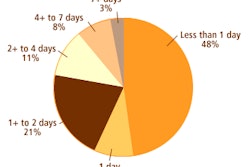A new study from the Washington University School of Medicine in St. Louis, MO, has found that people with more education appear to score higher on cognitive tests, despite having evidence of brain plaques associated with Alzheimer's disease.
Researchers wrote that these results "suggest that more pathological burden was required among highly educated individuals than less educated individuals to manifest mild dementia of the Alzheimer's type, supporting the cognitive reserve hypothesis."
The study was published in the November issue of the Archives of Neurology (November 2008, Vol. 65:11, pp. 1467-1471).
Researchers analyzed patients at the Washington University Alzheimer's Disease Research Center from August 15, 2003, and January 8, 2008. In total, 198 subjects were diagnosed either as nondemented (161 people) or with dementia of the Alzheimer's type (37 people).
There were no significant differences between the Pittsburgh Compound B (PiB)-positive and PiB-negative groups regarding history of heart disease, hypertension, diabetes, or stroke.
PET and PiB
Researchers used the PET radiotracer carbon-11-labeled PiB (C-11 PiB) to image fibrillar beta-amyloid pathology in vivo. In individuals diagnosed with mild dementia of the Alzheimer's type, 12 subjects with 15 or more years of education were found to have higher uptake of C-11 PiB in the frontal cortex compared to levels in 13 individuals with six years of education.
"We found that people with low PiB uptake and few, if any, plaques in the brain had very few dementia symptoms and there was no association with education," said Catherine Roe, Ph.D., co-author of the study and a research instructor in Washington University's department of neurology. "For those with high PiB uptake and plaques in the brain, people did better on the cognitive tests when they had more education," she said.
PET imaging was performed on HR ECAT PET scanners (Siemens Healthcare, Malvern, PA) with C-11 PiB synthesized in accordance with a standard protocol. After a transmission scan to measure attenuation, C-11 PiB was administered intravenously with initiation of a 60-minute dynamic PET scan in 3D mode. The measured attenuation factors and a ramp filter were used to reconstruct the dynamic PET images.
Reference region
The researchers chose the cerebellum as their reference region because there is little specific binding of PiB in postmortem samples of cerebellar cortex, even among individuals with Alzheimer's disease at autopsy.
The combination of PET imaging and C-11 PiB allows researchers for the first time to look at the pathology in people who are alive. Until now, pathology only could be examined at autopsy. "Autopsy studies are very valuable, but you have a lag between when the person is cognitively assessed for dementia symptoms and death," Roe said. "With radiotracers, you have eliminated that time lag and you can follow people through time. It also shows promise in terms of drug trials to see how the disease progresses."
On each of three measures of global cognitive function, education interacted with PiB status to predict cognitive function, showing that participants with greater education maintained better global cognitive function in the presence of beta-amyloid pathology.
The study also noted that "cognitive reserve, as reflected in education, may have a stronger or earlier effect on specific cognitive processes compared with other cognitive processes. However, greater beta-amyloid deposition was related to worse performance on all of the tests examined here, either as part of an interaction effect or by itself."
Study limitation
While the study has a good size sample of 198 subjects with a variety of PiB levels, Roe noted one possible study limitation. Study participants had an average education level of 15.5 years, which is greater than the national average of approximately 12 years. "We don't exactly know what might happen if we looked at a sample of less average education," Roe said.
Regarding future research, Roe said the group would like to expand its analysis "to look at different cognitive variables beyond education, to other factors involved with cognitive reserve, like intellectual and social activities occupation."
There also is a theory that brain volume and the number of synapses and cells may play a role in resisting the pathology of Alzheimer's, but no definitive research has been conducted in this area.
As for a direct link between levels of brain activity and acuity and Alzheimer's disease, Roe said it is still premature to draw any definitive conclusions. "It could be genetic, which makes it easy to learn in school, makes you more resistant to amyloid in the brain, or it could modify the brain," she added. "To my knowledge, that is not clear yet."
By Wayne Forrest
AuntMinnie.com staff writer
November 14, 2008
Related Reading
WSJ: FDA supports imaging agents for Alzheimer's, October 24, 2008
PET with C-11 PiB can assess beta-amyloid brain deposits, August 12, 2008
PET scans help spot and classify dementia types, March 27, 2008
FDG-PET CAD scheme boosts diagnostic accuracy for Alzheimer's, October 2, 2007
FDG-PET can influence Alzheimer's, dementia treatment, September 6, 2007
Copyright © 2008 AuntMinnie.com




















